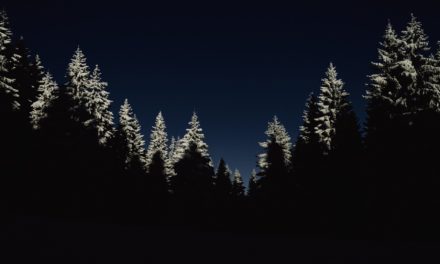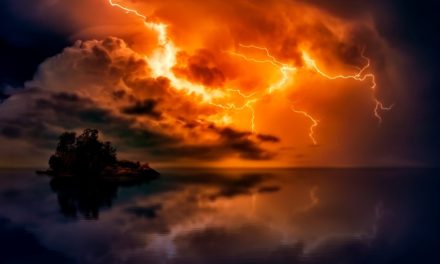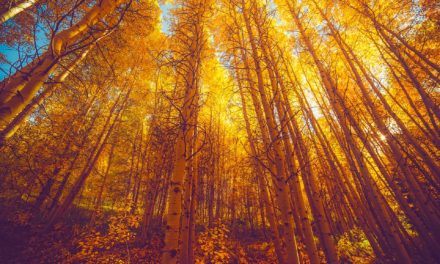Moments before we lost power, the TV meteorologist said, “We have new rotation touching down. If you live in Collegedale or Ooltewah, take shelter now! This is headed right toward . . .” Then silence, darkness in our Ooltewah home. We heard deep, rolling thunder. My husband ran to get our daughter from her upstairs bedroom, and we huddled in a downstairs closet. Louder thunder shook the house. The storm rattled like a train in the sky, high frequency layered over roaring bass. Lightning punctuated complete darkness. We heard branches battering outside walls, felt air currents pulling the entire structure. I prayed, leaning over our half-asleep child, and waited through slow-motion time. I waited for our windows to shatter or our roof to blow off. Our house could be destroyed any moment. I had never experienced such visceral fear. It was April 16, 2020—Easter night in Chattanooga, Tennessee.
Fifteen minutes later, the terrible noise subsided. Our house was still standing. We returned to bed in total darkness, keeping our daughter with us. I listened to her peaceful breath and tasted adrenaline. My own breathing was far from settled. Was it safe to sleep?
I remained tense until daylight, until we could see our branch-covered yard. Two large tree sections had fallen out back, closer to the creek than our house. Windows were intact. Our neighborhood was covered with debris, jumbled garbage totes and patio furniture. This group of homes was fortunate. No significant damage. We lost power for 30 hours, lost all refrigerated food, but we willingly accepted this inconvenience. Deep gratefulness overwhelmed me. Less than five miles from an EF 3 tornado, our home was okay.
Once internet was restored, I read updates from friends and acquaintances. Multiple friends had severe roof damage. Two would have to move out during clean-up. A large tree crashed through one friend’s bedroom wall, while a second tree entered her kitchen. Repairing the structural damage would take months. My daughter’s choir director lost her entire house, including the contents of her young son’s room. Her family barely escaped with their lives. As I read these storm accounts, my relief turned to a nauseous grief that lasted for weeks. This happened on Easter. What on earth, God? What on earth?
My own existential questions felt heavy enough. Then our daughter’s began: “Mom, why did God allow this tornado? Why would God let anyone lose their house?” My husband and I were still theologically tired from her Covid questions. The previous month, as we explained this new disease threat, my daughter had suddenly said one night at dinner, “So why is God allowing this virus, Mom? Why didn’t God make a perfect world? . . . ‘cause He could’ve!” She was five at the time, had turned six when the tornado came—a gifted child trying to assimilate child-like faith.
I explained that her questions were good and important ones that people of faith had been asking for centuries. I explained that sometimes people disagreed about the answers for why God allows great suffering. I told her we simply don’t know for sure, that storms are part of God’s creation and we don’t know why they can be so destructive. I assured her that God is with us in storms, even when we don’t understand. She listened—half accepting my answers, half holding a remainder of doubt. I could see on her little face: God still had more to answer for.

In the weeks that followed, I remember snapshots of hope:
Sitting in a long line of cars for a school district donation drive. Masked volunteers assembling pyramids of groceries, diapers, and cleaning supplies onto categorized tables. Trying not to cry as I unloaded our offering. Saying “thank you” through my mask as I handed our boxes to a masked man, and his muffled “thank you” in return.
My husband describing piles of tornado debris he gathered with a church group.
Taking a dinner casserole to the hotel where the choir director had relocated with her family. My daughter telling her, “I’m sorry you lost your house.” More tears as we drove home.
Hearing the new song “Peace Be Still” and claiming it as my storm recovery anthem. Dangerous wind was no longer a metaphor. This song spoke to post-tornado stress disorder.
Jenkins Road bisects the epicenter of tornado damage. Following the storm, the devastation on that road was overwhelming. The once lush, tree-covered land looked like a war zone. The storm ripped some houses from their foundations. Many more were ripped halfway. Roofs were gone. Upper levels, missing walls, showed bare interiors stripped by wind and rain. Water-soaked furniture decorated yards.
As I drove up the steep hill to a friend’s neighborhood, the scene became an optical illusion. On one side of the road, every bush and tall tree had vanished. Uprooted trunks stuck out at different angles, like grotesque spilled toothpicks. Where once only one layer of tree-surrounded homes had been visible, I could now see far into the distance, across rows of Appalachian foothills. A cruel lawnmower had plowed a stark, diagonal swath across neighborhoods.
My stomach clenched. I felt nauseous driving through this landscape. It was surreal, unrecognizable. My heart accelerated with fear, as if driving here would flatten me, too. When I arrived at my friend’s house, we cried and hugged.
“Driving here was terrible,” I said.
“I know,” she replied. “We have to see this every day.” She had lost power for two weeks, but her house was unharmed. We marveled at the protection of this valley, when neighbors just over that hill had lost everything.
What on earth, God? Why on earth?
For the next year, I braced myself for painful scenery when I had to drive Jenkins Road. The land was bruised, ugly without trees. Many blocks presented a devastating diorama of families forced to rebuild, living for months with a tarp roof or starting from a cement foundation. I drove out of my way to avoid that route. Seeing the damage reminded me of huddling in the closet that night, hearing wind that I thought would destroy us.
When our church re-opened in 2021, we began attending in person and driving down Jenkins Road. Every Sunday, I again saw what the storm had done, but also what time and the seasons were up to. In summer 2021 and throughout 2022, the scene gradually became dotted with new growth, and I could drive it without tears. Small plants popped from the earth, still dwarfed by eerie tree trunks stripped of branches. Weeks later, tiny buds of green appeared on new, delicate branches. The strange sight was changing, the war-zone look replaced by scattered green carpet. I started to look forward to seeing what new thing might grow.
On the last Sunday in March 2023, nearly three years after the tornado, the landscape surprised me again. As we drove to church, the sun broke through morning clouds, highlighting signs of spring. As we crested a ridge and drove into the tornado area, I gasped and whispered, “It’s beautiful.” Along Jenkins Road, a large field that the tornado had stripped of trees—a place utterly destroyed—was now filled with at least 100 pear trees, blooming white in the sunlight. They stood thin and tall, fragile, but glowing and happily new. Surrounding the oval puffs of white was a carpet of lime-green tree stems and a few dots of purple blooms, reaching in all directions. It could have been a painting or postcard. My eyes filled with tears, this time not from pain at destruction, but in awe of beauty that I never expected to see in that space again. Creation continued. This land was being recreated before our eyes.
I said to my daughter, “Look at what’s blooming! Even where the tornado did the most damage, new life comes, and it’s beautiful.”

Tornadoes come to Tennessee every spring now, and we fear them. We have bought weather radios and have learned what emergency supplies to bring into closets with us. We are more prepared for actual storms.
Yet after seeing this scene of surprising beauty, I feel more prepared to answer my daughter’s questions, too. We may not know why creation includes tornadoes, but we know that new life comes afterward. We know God is still creating, and gorgeous blooms can fill a desolate landscape. Hope for new life is real, because we have seen it grow from scarred earth.
It took three years rather than three days, but this is Resurrection.






